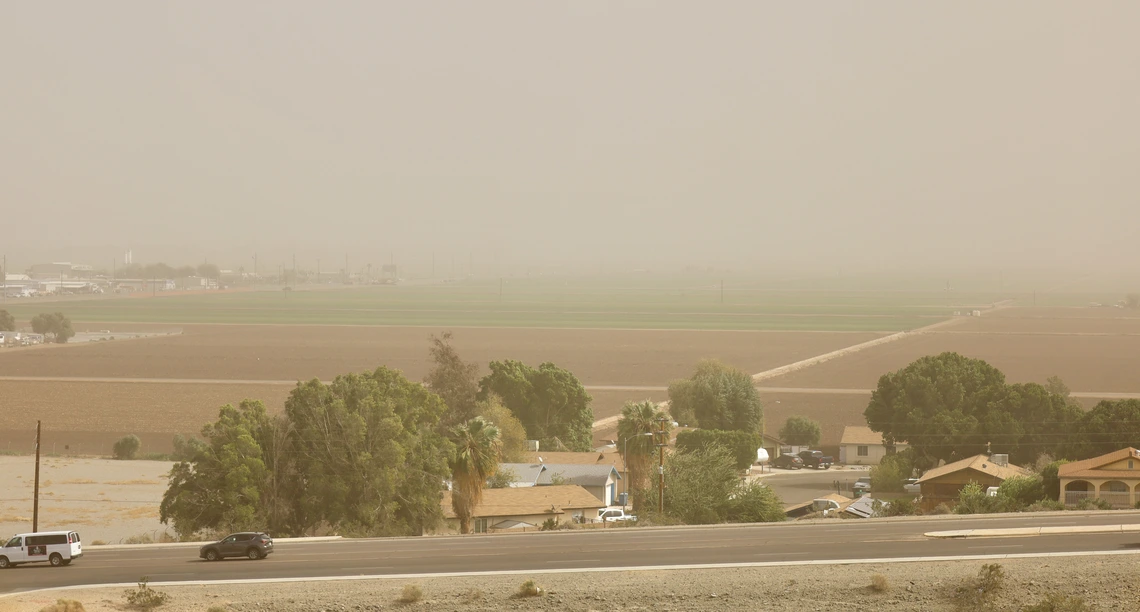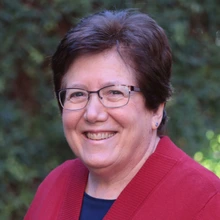Water Resources Research Center collaborates globally
From Arizona to the Middle East, WRRC partnerships help farmers, ranchers, government agencies and many others manage a vital natural resource in the face of changing climate.

Blowing dust obscures the horizon on a windy Yuma, Arizona day in February 2023.
Brad Poole, Cooperative Extension
University of Arizona Cooperative Extension has hundreds of partners across the state in scores of federal, tribal, state, and local governments; public and private schools and universities; and businesses and non-profits in many sectors of our economy and culture. Partnership is central to Extension’s mission to connect people with research.
UArizona’s Water Resources Research Center, founded in 1964 and later made part of Extension, has since its inception collaborated with state agencies, researchers from UArizona and other institutions, and many others to help academics, decision-makers, and the general public understand and find ways to effectively manage one of the West’s most precious resources.

Sharon Megdal
With the WRRC annual conference, Implementing Water Solutions Through Partnerships, approaching March 12-13, we asked WRRC Director Sharon Megdal, Ph.D., about collaboration and how it relates to two agriculture-centered partnerships she has undertaken. First a five-year, USDA-funded partnership with University of California - Davis, Sustaining Groundwater and Irrigated Agriculture in the Southwestern United States under a Changing Climate and next UArizona President Robert C. Robbins’ Commission on the Future of Agriculture and Food Production in a Drying Climate.
The USDA project involves interdisciplinary collaboration among researchers at UArizona, the University of California – Davis, and others. The president’s commission is an internal collaboration that identified threats to agriculture and ways the University can help.
Good morning Dr. Megdal. Thanks for giving us a few minutes of your time to talk about these projects. Collaboration is a big part of Extensions mission and identity. How do you approach partnerships, and how does the WRRC intersect with agriculture?
Key to establishing partnerships is good communication. It is important that those with who we engage know what we’re doing. We want partners to have the opportunity to comment and provide input. Good communication at all stages of a project helps avoid surprises and enables us to deliver a better product or outcome.
Sometimes collaboration is really just good communication. I’m a big believer and, I hope people would recognize, practitioner of engagement and good communication so that people know what we're doing, so people have the opportunity to comment and provide input. You don't want people surprised or suspicious. I'd rather be upfront, and let people know, let them ask questions rather than be surprised by anything.
We are an outward-facing unit for Extension at the university when it comes to water, and as a collaborative entity, the WRRC works with all water users in the state, including agriculture, the largest user of water in Arizona. Our annual conference is our signature event, and in the 20-plus years we have been holding an annual conference, multiple conferences focused on ag. We issue publications, too. Our 2023 Arroyo publication on the outlook for Arizona agriculture includes fact sheets to help the public understand things about agriculture, not only the water experts and students.
For projects like the NIFA groundwater study, how does collaboration happen?
Our collaboration starts early. I like to reach out to people (before funding is approved), sometimes inviting the organizations or individuals to serve on an advisory board and tell them about the project, as opposed to waiting until I get the project funded, and then just come in and say, “Well, we need an advisory board for this project, can you serve?”
(For the NIFA project) I collected letters of support from some irrigation districts, the Arizona Association of Conservation Districts, the chairman of the Pinal County Board of Supervisors, and the Arizona Cotton Growers Association. Long-time farmer Ron Rayner and Brian Yerges, General Manager of the Maricopa-Stanfield Irrigation and Drainage District, represent Arizona on the project’s Advisory Board.
Another approach to collaboration and communication is following up. Last year, after we were involved in the project for one year, we convened a meeting at the Maricopa Ag Center to report on the progress of our Arizona-focused work. We had about 35 there with several more attending virtually. We had news coverage of the meeting.
You served on President Robbins’ commission on the future of Arizona agriculture and are now on the follow-up implementation committee. What were the goals of that commission, and what were some of the recommendations?
The question is, how are we going to meet the needs for food not only for Arizona, not only for the country, but for the world, because there are growing populations and increasing demand. How can Arizona agriculture remain vibrant when facing pressures of urbanization and competition for water supply?
In this context, we looked at ways that we at the University of Arizona can contribute to addressing the challenges to agriculture and food production. We not only looked at our people assets, but we considered university assets, such as the Maricopa Agricultural Center or Yuma Agricultural Center. Let's see how we can make them technology and innovation hubs, which was already happening to some extent.
Did the commission identity ways collaboration can help agriculture stay vital in Arizona?
Yes, we focused a lot on how we can partner with agriculture, including tribal agriculture. Commission member Levi Escuerra, Senior Vice-President for Native American Advancement and Tribal Engagement, helped the commission members recognize that tribal agriculture is an important part of Arizona's agriculture. Many tribal farmers are small landholder farmers, but there's large scale agriculture going on tribal lands, also. And there's also small-scale agriculture on non-tribal lands. From my vantage point, there's not a lot of communication across the two, meaning tribal and non-tribal agriculture. It’s really important to make sure that we expand upon the University’s existing partnerships with tribal agriculture. But we should better connect agriculture across the whole state, be it tribal or non-tribal.
Another collaboration opportunity is to establish new and strengthen existing collaborations with institutions in arid regions around the world. And there is so much need for research for piloting new irrigation methods and/or new crops, like studies we have going on in Extension right now, such as through the Water Irrigation Efficiency Program.
Click here to read the final report from the Commission on the Future of Agriculture and Food production in a Drying Climate.
Some other key recent WRRC collaborations
Transboundary Aquifer Assessment Program – Megdal is the lead University of Arizona primary investigator for this binational program is seeking ways to better characterize groundwater across the U.S.-Mexico border.
Middle East partnerships – Megdal is one of two University of Arizona board members for the Kasser Joint Institute for Food, Energy, and Water Security (KJI), a partnership of the University of Arizona, Jewish National Fund (JNF)-USA, and the Arava Valley in the South of Israel and served on the Scientific Committee for the first and second Water Resources Management and Sustainability: Solutions for Arid Regions International Conference, hosted by the United Arab Emirates University, Dubai.
Arizona County water factsheets – WRRC has been working with municipal, nonprofit, extension, county, state, and federal partners to develop county-specific water factsheets for all 15 Arizona counties. The fact sheets, 11 out of 15 of which are complete, fill a gap in accessible and comprehensive water information at the county scale.
Click here to read more Arroyo publications.
See the WRRC website for information about the center's partnerships, research, outreach, and education.

